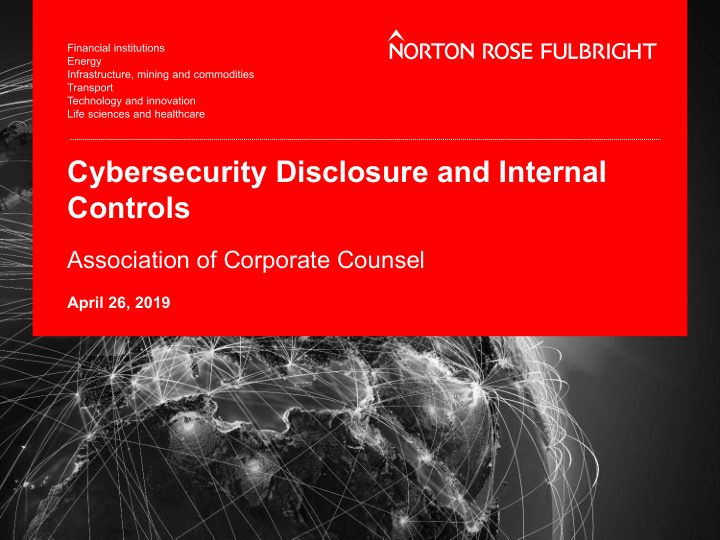



Cybersecurity Disclosure and Internal Controls Association of Corporate Counsel April 26, 2019
SEC’s Increasing Emphasis on Cybersecurity • The SEC formed a dedicated cyber unit in 2017 • According to the SEC Enforcement Division’s FY 2018 annual report, the SEC brought 20 cyber-related enforcement actions last year • The SEC has over 200 open cyber-related investigations 2
Overview and Implications of SEC’s Guidance on Cybersecurity Disclosures • In February 2018, SEC issued interpretive guidance “to assist public companies in preparing disclosures about cybersecurity risks and incidents” • Guidance emphasizes Board’s role in cybersecurity risk oversight • May need to disclose prior or ongoing cybersecurity incidents in order to place discussions of risk in the appropriate context • Disclosure controls should ensure that appropriate personnel have necessary information about cybersecurity risks and incidents so fully informed disclosure decisions can be made 3
SEC Guidance: Disclosure Timing, Corrections, and Updates • Timing of Incident Disclosures – “[W]e recognize that a company may require time to discern the implications of a cybersecurity incident” – “[A]n ongoing internal or external investigation – which often can be lengthy – would not on its own provide a basis for avoiding disclosures of a material cybersecurity incident” • Correcting and Updating Disclosures – May have duty to correct prior disclosure if determine untrue at time made, such as by discovering contradictory information that existed at time made – May have duty to update disclosure if it becomes materially inaccurate after made – Should consider whether need to revisit or refresh during the process of investigating a cybersecurity incident 4
SEC Investigative Report on Cybersecurity Internal Controls • On October 16, 2018, SEC issued investigative report emphasizing that public companies must consider cyber threats when implementing internal accounting controls – Companies must safeguard investor assets from cyber-related frauds • Key Takeaways – Continually assess cybersecurity risks and calibrate internal controls accordingly – Factor human vulnerabilities into control design – Companies had appropriate policies in place but various aspects were ignored or misunderstood – Evaluate insider trading policies in relation to knowledge of cybersecurity risks and incidents 5
Types of Threats Data Breach Financial data Personal data Customer data Knowledge Assets Intellectual property Business plans Critical Infrastructure Cyber Attacks Shutdown of operations Target control systems to cause physical harm and property destruction Ransomware Data as hostage Destruction of data
Lifecycle of a Cyber Attack Data is Compromised Attack Stage Maintaining • Data theft the Back Door Weapon/ • Data destruction Malware • Espionage • Unmonitored ports Delivery Opening • Denial of service • Misconfigured data the Door • Spyware • Unauthorized system loss prevention tools Intelligence • Ransomware and network access • Spear phishing Collection • Stolen access • Rootkit • Cyber crime • Drive-by download credentials • Peer-to-peer • Bot • Software/hardware networks vulnerabilities • Search engines • Third-party • Social engineering compromise Time Time to Exploit: Minutes Time to Discovery: Months or Longer Source: Deloitte Development LLC
Cyber Security as a Material Risk 1. Businesses are increasingly targeted 4. Everything can’t be protected equally § Fraud – millions of dollars in losses § Identify the ‘ crown jewels ’ and high-impact, high- § IP theft – corporate espionage risk individuals/events – prioritize and invest in § Customer data theft – financial data theft controls based on risk decisions § Denial of service – disruptions in operations (e.g., § Plan, budget, track, and report on the effectiveness shutdown of industrial processes) and loss of of cybersecurity programs and internal controls customer trust § Physical harm – attacks designed to cause harm 5. Traditional controls are necessary but 2. Cyber damages go beyond dollars should be augmented § Determine your risk tolerance and the cost of § Perimeter defense is no longer sufficient protection § Understand the impact of changes in privacy laws and cybersecurity standards and the need for continual assessment § Human error/lapses continue to be one of the key 3. Speed of attack is increasing, response reasons for breaches times are shrinking, and the tail of a crisis-level data breach is long 6. Regulators, government, and the media are key stakeholders with ever increasing focus § It only takes minutes to compromise and it may take years to recover § Cyber security is a team sport. The General § Understand the importance of communications and Counsel’s office has a critical role to play in messaging, especially during a time of crisis managing a cyber security incident as does the CISO.
Cybersecurity Risk Assessment Best Practices • Conduct a risk assessment to identify and prioritize important systems and information, the most likely threats to those systems, and the best controls to reduce or eliminate those threats • Risk Identification Process – Create a inventory of systems and data – Determine the criticalness of systems and data – Identify key vulnerabilities and threats to systems and data – Collect and classify controls 9
Recommendations for Managing Cybersecurity Risks 1. Ensure the board or a committee has appropriate cybersecurity authority and responsibility 2. Document board oversight efforts 3. Implement policies and procedures related to cybersecurity risks and incidents 4. Have a plan to address identified security vulnerabilities 5. Train and educate directors and employees 6. Review disclosures 7. Review insurance coverage 8. Proactively respond to cyberattacks 10
About Norton Rose Fulbright Key industry strengths Global footprint Energy Financial institutions Infrastructure, mining and commodities Transport Technology and innovation Life sciences and healthcare Business principles Quality. Unity. Integrity. 58 Offices, including locations in major energy and financial markets 4000+ Lawyers and other legal staff worldwide (900+ in US) 11
Recommend
More recommend